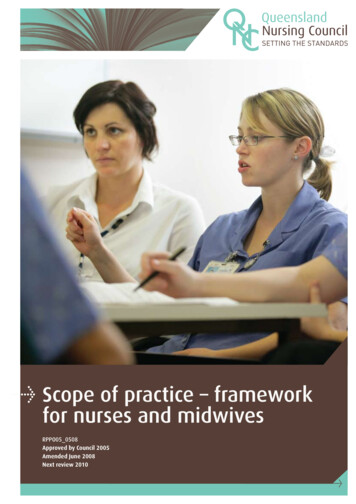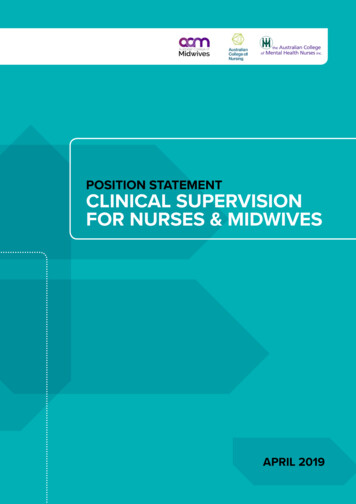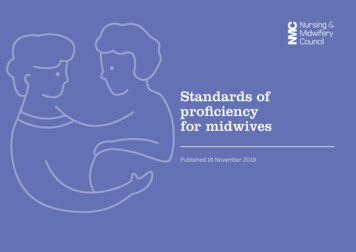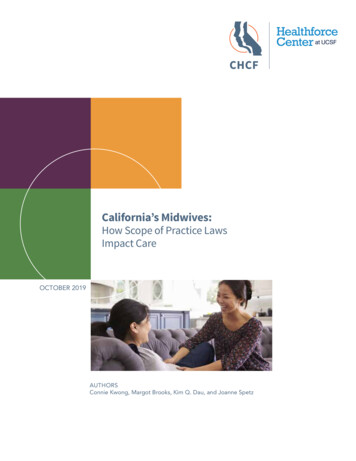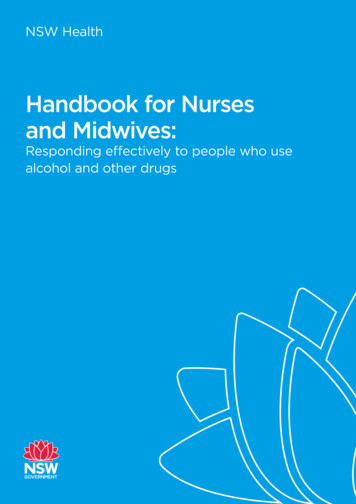
Transcription
NSW HealthHandbook for Nursesand Midwives:Responding effectively to people who usealcohol and other drugs
NSW Ministry of Health1 Reserve RoadST LEONARDS NSW 2065Tel. (02) 9391 9000Fax. (02) 9391 9101TTY. (02) 9391 9900www.health.nsw.gov.auThis work is copyright. It may be reproduced in whole or in part for study or trainingpurposes subject to the inclusion of an acknowledgement of the source. It may not bereproduced for commercial usage or sale. Reproduction for purposes other than thoseindicated above requires written permission from the NSW Ministry of Health.The NSW Ministry for Health acknowledges the traditional custodians of the landsacross NSW. We acknowledge that we live and work on Aboriginal lands. We pay ourrespects to Elders past and present and to all Aboriginal people.Further copies of this document can be downloaded from the NSW Health webpagewww.health.nsw.gov.au NSW Ministry of Health 2021SHPN (CPH) 210385ISBN 978-1-76081-740-4May 2021iiNSW HealthHandbook for Nurses and Midwives: Responding effectively to people who use alcohol and other drugs
Contents1Foreword32 About the Handbook43 Principles of Practice54 Understanding substance use64.1Understanding dependence64.2 Understanding hazardous andharmful use74.3 Harm reduction75 Person-centred care5.1Stigma and discrimination5.2 Trauma-informed care5.3 Confidentiality5.4 What happens if a patient refusesassessment, treatment or referral?5.5 Cultural competency5.5.1 Aboriginal and Torres StraitIslander communities9236.2.1 Consultation with specialistAOD services236.2.2 Pregnant women246.2.3 Neonatal abstinence syndrome(NAS)256.2.4 Young people267 Responding to and managing risksand needs277.1Risks of polysubstance use277.2Identifying and managingintoxication287.2.1 Assessing for causes otherthan intoxication28107.2.2 Managing intoxicated behaviour28117.2.3 Managing intoxicated behaviourin a clinical setting297.2.4 Alcoholic hallucinosis30Overdose309910117.35.5.2 Culturally and LinguisticallyDiverse (CALD) Communities137.3.1 Identifying overdose305.5.3 Gender and sexually diversecommunities147.3.2 Assessing an intoxicated personfor signs of overdose305.6 Other vulnerable populations5.6.1 Pregnant women15155.6.2 People living in rural and remotecommunities155.6.3 Young people155.6.4 People in contact with thecriminal justice system175.6.5 Managing people with co-existingconditions176 Core Processes of Care 1:Screening and Assessment6.16.2 Referral to comprehensiveassessmentScreening for the use of AOD6.1.1Quantifying and documentingsubstance use207.3.3 Managing overdose7.3.4 Recognising deterioration7.4 Withdrawal3132337.4.1 Identifying withdrawal337.4.2 Monitoring withdrawal357.4.3 Principles of withdrawalmanagement357.4.4 Alcohol withdrawal delirium(previously known as deliriumtremens)367.5 Identifying and managing other risks 36207.5.1 Blood-borne viruses (BBV)or infection36207.5.2 Risk of harm to self or others,deteriorating mental health377.5.2a Screening for suicide risk376.1.2 Screening questions216.1.3 Screening tools and standardsmeasures226.1.4 Treatment of an inpatientwho is on an Opioid TreatmentProgram (OTP)226.1.5 Brief intervention22NSW Health Handbook for Nurses and Midwives: Responding effectively to people who use alcohol and other drugs1
7.6Identifying and managing familyand social needs387.6.1 AOD use and child wellbeingand child protection387.6.2 Defining abuse and neglect397.6.3 Accidental or intentionalconsumption of methadone orbuprenorphine by a child407.6.4 Homelessness or risk of eviction407.6.5 Concerns regarding a pregnantwoman or newborn child417.6.6 Violence including domestic andfamily violence418 Core Processes of Care 3:Care Planning8.143Key principles of care planning8.2 Care planning43438.2.1 Example of a care plan8.3 Monitoring and review11.2 Drug & Alcohol Specialist AdvisoryService (DASAS)7711.3 Quitline Service7811.4 NSW Health Care InterpretingServices7811.5 Other AOD service contact details7811.6 Inpatient and residential withdrawalmanagement services (NSW Healthfunded)7911.7 Residential rehabilitationservices (NSW Health funded)12 General education and trainingresources8082824512.2 Supervision resources829 Core Processes of Care 4: CareCoordination and Transfer of Care46469.2 Transfer of care77Local health district and specialityhealth network AOD service centralintake numbers7712.1 My Health Learning45Care coordination11.1448.3.1 Areas with access to specialistassessment9.111 Useful contacts469.2.1 Considerations for nursing andmidwifery practice469.2.2 Steps for transfer of care4713 Self-care for nurses and midwives13.1 Definitions838314 Resources8415 Glossary9016 References949.2.3 Transfer of care between treatingclinicians and service providers489.3 Discharge planning9.3.1 Liaison and referral to serviceson discharge499.3.2 Discharge summaries499.3.3 Unplanned cessation oftreatment499.3.4 Steps to guide care coordinationand transfer of care5010 Drug Compendium249NSW Health51Handbook for Nurses and Midwives: Responding effectively to people who use alcohol and other drugs
1 ForewordAlcohol and other drug (AOD) use pervades most aspects of our society. As healthcare professionals, nursesand midwives often care for people affected by the use of these substances. In fact, there is no area ofnursing or midwifery practice excepted from people who experience substance-related harm.The Handbook for Nurses and Midwives: Responding effectively to people who use alcohol and other drugs(hereafter referred to as the Handbook) provides clear, consistent and detailed pathways for delivering careacross the domains of screening and assessment; identifying and responding to acute and chronic physical,mental health and social needs and risks; care planning; care coordination; and transfer of care.Embedding a health system response to AOD use is a key objective of the NSW Health strategic priority toKeep People Healthy. To achieve this objective, it is essential that nurses and midwives have the expertise,resources and skills to deliver healthcare for people experiencing harms associated with AOD use. We havea responsibility to provide person-centred care and ensure that, regardless of the reason for presentationto a health service, people experiencing harm from substance use receive safe high-quality care.Research evidence, clinical experiences and feedback from consultations with a broad range of stakeholdershave informed the development of this Handbook. Extensive input from nurses, midwives and clinicalexperts working within a variety of health specialities, including AOD, has ensured alignment with policyand relevance across all care settings.Our nursing and midwifery workforce can provide dynamic and responsive interventions that improvepatient experiences across all services. Targeting the needs of people experiencing harm from substanceuse has the potential to transform the way we deliver healthcare, change lives and keep society healthy.I encourage all nurses and midwives to use the Handbook to improve the care outcomes for people who areaffected by harms associated with alcohol, tobacco and other drug use. I encourage you to work with yourpatients to dispel myths, remove stigma and improve patient experiences by delivering timely, holistic andperson-centred care.Yours sincerelyJacqui CrossChief Nursing and Midwifery OfficerNSW Ministry of HealthNSW Health Handbook for Nurses and Midwives: Responding effectively to people who use alcohol and other drugs3
2 About the HandbookThe Handbook provides nurses and midwives inNSW with clinical guidance and support for theprovision of safe and high-quality care for peoplewho use AOD.Every nurse and midwife should use the Handbookwithin the context of their role and scope ofpractice. The Handbook is designed to guidenursing and midwifery practice in the context of thecore processes of care, which include: Screening and assessmentIdentifying and responding to risksCare planningCoordination and transfer of careThe introductory sections 3-5 give an overview of thecontext and prerequisite knowledge for the deliveryof safe person-centred care. It is not the remit ofthis Handbook to provide specific information onthe clinical implications of the use of alcohol andother specific drugs.The intention is that nursing and midwifery staff willlink their care and practice to evidence-basedclinical guidelines available from NSW Health asoutlined below.Person using alcoholand other drugsNurse or midwifeLink care toevidence-basedclinical guidelines4NSW HealthLinks to relevant resources and guidelines can befound throughout the document. The appendicesalso provide links to resources and guidelines foreach section. A drug compendium is included inthis Handbook to provide an overview of specificdrug types and effects.Nurses and midwives are encouraged to liaise withlocal AOD services, use local assessment tools andfollow local protocols. In the absence of localspecialist services, a state-wide Drug & AlcoholSpecialist Advisory Service (DASAS) is available24/7 to support all clinicians in the delivery of care.Nurses and midwives can reach the DASAS line on1800 023 687 (Country) or 9361 8006 (Sydney).The Handbook is underpinned by key principlesof practice and accompanied by the NSW HealthPolicy Statement and Procedure PD2020 032:Nursing and Midwifery Management of Drug andAlcohol use in the Delivery of Health Care.Copies of additional guidelines and updates can bedownloaded from the NSW Health dslanding.aspxPresentation or admission: ED/hospital ward Mental Health/other specialist service Maternity/antenatal care Community settingUse Policy Directive and Guidelines for: Screening and assessment Identifying risks Planning care with patient Coordinating care with treating teams Organising transfer of careAOD Clinical Guidelines: Opioid Treatment Guidelines Substance Use in Pregnancy Guidelines Other clinical guidelines as appropriateHandbook for Nurses and Midwives: Responding effectively to people who use alcohol and other drugs
3 Principles of PracticePrinciple 1: Services are person-centredServices are provided within a trusted, inclusive and respectful culture that values and promotes a beneficialpartnership between patients, their significant others and staff. The service respects diversity and isresponsive to patients’ needs and values. The experience of patients and their families is acknowledged inthe service system.Principle 2: Services are safeServices are continuously striving to improve outcomes by considering the physical, psychosocial, culturaland spiritual wellbeing of all patients and minimising the risk of harm.Principle 3: Services are accessible and timelyThe service system is visible, accessible from multiple points of entry, equitable and timely. Patientsexperience care as welcoming, accepting, non-judgmental and responsive to their needs.Principle 4: Services are effectiveServices are holistic, evidence-based and supported by NSW Health-endorsed standards, policies andguidelines. The service system attends to the diverse physical, psychosocial, cultural and spiritual needs ofpatients. The continuum of care is integrated across NSW Health, primary care and non-governmentorganisations to reduce fragmentation and improve outcomes.Principle 5: Services are appropriateThe service system provides a range of approaches to meet the diverse needs of patients. Patients areinformed of, and engaged in, influencing services, treatment, and options in a clear and open way. Nursesand midwives utilise links and refer patients to alcohol and other drug (AOD) specialists as appropriate.Principle 6: Services use their resources efficientlyServices maximise the use of available resources to deliver sustainable, high-quality care. Services ensureclose alignment and integration across other services and sectors to avoid duplication or omission ofservice.Principle 7: Services are delivered by a skilled and knowledgeable workforceThe workforce has the requisite skills, knowledge, values and attitudes to respond to patients’ needs, and acapability and willingness to work across disciplines and sectors.Principle 8: Services minimise stigma through the use of appropriate languageLanguage is powerful when discussing harm associated with the use of AOD. Services support staff to applynon-judgmental language that reduces negative stereotypes and focuses on the person, not their substanceuse. Nurses and midwives are aware that the fear of stigma or being labelled can and does prevent peoplefrom accessing treatment and support and contributes to poorer treatment outcomes.NSW Health Handbook for Nurses and Midwives: Responding effectively to people who use alcohol and other drugs5
4 Understanding substance use4.1 Understanding dependenceSubstance use is a normal part of people’s lives,and although many people drink alcohol or usedrugs, not everyone suffers harm to their physicalor mental health. Understanding substance usemeans identifying the reasons a person may bedrinking alcohol or using drugs rather than justfocusing on the substance used.In the 5th edition of the Diagnostic and StatisticalManual of Mental Disorders (DSM-5), dependence isdefined as ‘a cluster of cognitive, behavioural andphysiologic symptoms that indicate a person hasimpaired control of psychoactive substance use andcontinues use of the substance despite adverseconsequences’.1The World Health Organisation (WHO) lexicon ofalcohol and drug terms2 identifies dependencesyndrome as ‘a cluster of behavioural, cognitive,and physiological phenomena that may developafter repeated substance use’. These phenomenainclude: A strong desire to take the drug Increased toleranceImpaired control over its usePersistent use despite harmful consequencesA higher priority given to drug use than to otheractivities and obligationsExperience of physical withdrawal reaction whendrug use is discontinuedThe dependence syndrome may relate to a specificsubstance (e.g. nicotine, alcohol, diazepam), a classof substances (e.g. opioids), or a wider range ofpharmacologically diverse substances. Dependencealso occurs on a continuum from mild to moderateto severe. There may also be different treatmentoptions for patients based on their level ofdependence. For example, for patients dependenton opioids, pharmacotherapy options such asmethadone or buprenorphine as offered in theOpioid Treatment Program (OTP) can be useful.For further information, refer to NSW HealthGuidance GL2018 019: NSW Clinical Guidelines:Treatment of Opioid Dependence.Spectrum of abuseDependenceHarmful useHazardous useNon hazardous useAbstainer/non user6NSW HealthHandbook for Nurses and Midwives: Responding effectively to people who use alcohol and other drugs
4.2 Understanding hazardous andharmful useHarmful use is determined by a pattern of substanceuse that causes damage to health. The damage maybe physical (e.g. hepatitis following injection ofdrugs) or mental (e.g. depressive episodes secondaryto heavy alcohol consumption). Commonly, but notinvariably, harmful use has adverse socialconsequences. Social consequences alone are notenough to justify a diagnosis of harmful use.The term ‘harmful use’ was introduced in the 10thedition of the International Statistical Classificationof Diseases and Related Health Problems (ICD-I0)and supplanted ‘non-dependent use’ as adiagnostic term. 3 The closest equivalent in otherdiagnostic systems, such as the DSM-5, is‘substance abuse’, which usually includes socialconsequences.1A person using substances at harmful levels hastypically experienced at least one of the followingfactors in the previous 12 months: Recurrent use resulting in failure to fulfilobligations at work, home or school Recurrent use in physically hazardous situationsRecurrent substance-related legal problemsContinued substance use despite persistent orrecurrent social or interpersonal problemscaused by or worsened by the substance.Harms associated with substance use will varydepending on the drug used and the amountconsumed.AOD use at harmful or hazardous levels can impactpatients regardless of race, cultural background,education, religion, gender and age. Nurses andmidwives should recognise that AOD use is common,and those who use these substances may be affectedby stigma and discrimination by healthcare staff.(e.g. tobacco, alcohol, prescription or over-thecounter medications) or illegal (e.g. someamphetamines, cannabis or non-prescriptionopioids). In each case, the nurse or midwife mustconsider the clinical and social implicationsassociated with any substance used.The harms associated with a person’s AOD useshould also be considered within the broadercontext of the effect it may have on others, such asfamily. Identifying whether the person is a parent orcarer of a child or young person, or if they care foran older person, should be considered. Effects ofparental AOD use on children include: Increased likelihood of experiencing emotionalstress and developing social, emotional andbehaviour problems Higher risk of tobacco smoking and futuredevelopment of AOD problemsCurrent guidelines Alcohol – there are guidelines and documentedrisks associated with the consumption of alcohol.For current guidelines, refer to ‘NHMRCAustralian Guidelines to reduce health risks fromdrinking alcohol’4 online. Tobacco smoking – there is no safe level ofconsumption. Prescribed and non-prescribed medication– risk depends on quantity and frequency of use.Prescribed medications should be recorded astaken, which may be different from the way theyare prescribed. Illicit drugs – are difficult to quantify because thesame drug can be available in widely differentdoses and composition, with potential foradulterants or contaminants. When documentingillicit drug use, record the type and amount ofsubstances ingested (eg capsules or tablets),number of injections and/or cost of drug.Increased hazardous or harmful use is oftenconnected to other personal health or psychosocialissues. There are multiple reasons people use AODand it is recognised that the reasons may vary foreach patient and substance. It is important fornurses and midwives to understand the impact ofsubstance use on patients, their relationships withothers and the wider population.4.3 Harm reductionAssumptions about people who use AOD are oftenbased on stereotypes. Nurses and midwives willencounter people who have used substances forvarious reasons. Substances may be legalA priority for NSW Health is to embed a systemresponse to AOD use. The system response will beachieved by upskilling healthcare workers andraising awareness of substance use-related harms.Harm reduction is an approach based on reducingor minimising the harms associated with substanceuse. This approach does not accept or encourageunsafe substance use. It simply acknowledges thatabstinence from substance use is one of a range ofstrategies and not the only way to help patients.NSW Health Handbook for Nurses and Midwives: Responding effectively to people who use alcohol and other drugs7
Harm reduction is currently the key policy directionfor health professionals working in AOD. Nursesand midwives are important in providing harmreduction messages and relevant intervention, asthey are often the first point of contact for peoplewho use AOD at hazardous or harmful levels.Strengthening the clinical knowledge and skills ofnurses and midwives benefits the community byreducing the burden of preventable harmsassociated with AOD use on the healthcare sectorand other services.Evidence-based harm reduction strategiescurrently found to be beneficial include: Decreasing AOD consumption over time. Inrelation to tobacco, there is limited evidenceabout the long-term health benefits of reducingsmoking over time compared to discontinuinguse entirely. Nicotine replacement therapy can be effective tohelp manage and quit tobacco smoking. Assessing and addressing AOD use at variouscontact points such as emergency departments,general health clinics, pre-admission clinics,diabetes clinics, midwifery services, sexualhealth clinics, mental health services, and ingeneral practice. Providing access to AOD withdrawal servicesand rehabilitation services. Providing access to naloxone to reverse theimpacts of opioid toxicity. Providing sterile injecting equipment includingdisposal units, needles, syringes and swabs. Providing information about how to accessconfidential needle and syringe programs. Implementing health promotion campaigns, suchas those focusing on preventing young peoplefrom taking up smoking, raising awareness of therisks of drink spiking in pubs and clubs, andpromoting light beer. Providing access to specialist AOD services.Some of the potential negative impacts of AODuse are: Alcohol use has both short- and long-termeffects on basic motor coordination and morecomplex executive function tasks, such as theability to plan, organise and make decisions. Itcan also have mild to severe physical impacts.Alcohol use is often overlooked or trivialised dueto its legality and socially accepted use.Tobacco smoking harms almost every organ inthe body. Research estimates that in Australia,up to two-thirds of deaths among currentsmokers are attributable to smoking; they loseon average a decade of life. The number of people dependent on prescribedopioids is increasing. Tolerance of, and dependence on, prescriptionanalgesics and benzodiazepines can developwhether these drugs are prescribed or not. Amphetamine use is linked to psychosis andcardiovascular abnormalities. Methylenedioxymethamphetamine (MDMA) hasbeen linked to several well-publicised deathsfollowing its use at festivals and dance parties. Psychostimulant toxicity poses a medicalemergency. Cannabis use has shown to impair cognitivefunctions on several levels, from basic motorcoordination to more complex executivefunction tasks. Impaired functions include theability to plan, organise, solve problems, makedecisions, remember, and control emotions andbehaviour. These deficits vary in severitydepending on quantity, frequency of use, age ofonset and duration of cannabis use.8NSW HealthProviding pharmacotherapy treatment such asmethadone or buprenorphine for opioiddependence.To date, the Therapeutic Goods Administration(TGA) has not approved the use of e-cigarettes asa therapeutic product to help smokers quit. Thelong-term harms of e-cigarettes are not known.Nurses and midwives should assess whether apatient is using e-cigarettes (commonly referred toas ‘vaping’). Cessation of all tobacco use, includingvaping, should be encouraged. Since e-cigaretteshave not been assessed for safety, clinicians shouldprovide information on the limited evidence forsafe use. 5For further information about e-cigarettes, refer tothe NSW Health electronic cigarettes oniccigarettes.aspxHandbook for Nurses and Midwives: Responding effectively to people who use alcohol and other drugs
5 Person-centred careEngagement with patients is integral to providingsafe and high-quality services. When working in ahealthcare setting, it is essential that nurses andmidwives work with patients to meet their goalsand needs. For patients who use AOD, it isespecially important to build rapport to avoidpatients feeling judged by healthcare professionals.Person-centred care is the delivery of healthcarethat is respectful of, and responsive to, thepreferences, needs and values of all patients.This Handbook supports the key principles ofperson-centred care, namely: Treating patients with dignity and respect. Communicating and sharing information withpatients about clinical conditions and treatmentoptions. Providing patients with information in a formatthat they understand so they can participate indecision-making.Encouraging and supporting patientparticipation in decision-making.5.1 Stigma and discriminationStigma is a fundamental social cause of healthinequalities. Stigma has been shown to increasestress, reinforce differences in socioeconomicstatus, delay or impede help-seeking, and lead toearly termination of treatment.6The individual values and beliefs of nurses andmidwives have the potential to impact a patient’sexperience of care. All patients who access NSWHealth services have the right to access care, freefrom stigma and discrimination. For patients whouse AOD, stigma involves labelling and stereotyping,which often leads to their exclusion and rejection.Discrimination, or the lived experiences of stigma,has been shown to impact the care and treatment apatient receives.6Stigma and discrimination may negatively impacta patient’s: Willingness to access medical assistance forfuture or ongoing treatment of health conditions. Ability to receive quality therapeutic care andtreatment from a broad range of healthpractitioners. Motivation to disclose their status of alcohol andor drug use, history of injecting, or associatedmedical conditions.The integration of screening and assessment intonursing and midwifery practice and theidentification of harm, or risk of harm, associatedwith substance use is critical to engaging patientswho use AOD in supportive care. Appropriatelytargeted interventions, treatment advice andreferral greatly enhance the opportunity forimproved health outcomes for AOD patients.Refer to the ‘Language Matters’ information sheetdeveloped by Network of Alcohol and other DrugsAgencies (NADA) and NSW Users and AIDSAssociation (NUAA) in Section 14: Resources.5.2 Trauma-informed careTrauma-informed care is a service delivery approachwhich recognises the high rates of exposure totrauma in the patient population. Trauma-informedcare provides a safe environment and accommodatesthe needs of patients presenting with a history ofsignificant trauma.7Traumatic events experienced by AOD patients mayinclude, but are not limited to: Being raised in a violent or negligent environment IncarcerationExperiencing physical or sexual assault(including domestic violence, child sexual abuseor other experience)Witnessing serious death or injuryBeing threatened with a weapon or held captiveExperience of warTraumatic events are often defining and lifechanging, whether a person receives a diagnosis ofpost-traumatic stress disorder (PTSD) or not.Self-medication for trauma may play a significantrole in AOD use. Trauma-informed care is integral toensuring that the impact of trauma is identified andconsidered in the treatment of a patient.NSW Health Handbook for Nurses and Midwives: Responding effectively to people who use alcohol and other drugs9
There are six key principles of a trauma-informedapproach which should be utilised by nurses andmidwives:1. Safety: making staff, patient and families feelphysically and psychologically safe.2. Trustworthiness and transparency: ensuringorganisational operations and decisions aretransparent, so that trust is built.3. Peer support: ensuring support is available andprovided by other individuals with livedexperience of trauma or their caregivers (peersmay also be referred to as ‘trauma survivors’).4. Collaboration and mutuality: levelling the‘playing field’ (power differentials) between staffand patients, and among organisational staff toensure a collaborative approach to healing.5. Empowerment, voice and choice: emphasisingthe strengths-based nature of trauma-informedcare. In this way the organisation and greaterservice delivery system fosters recovery andhealing.6. Cultural, historical and gender issues:incorporating processes that move past culturalstereotypes and biases, and policies, protocolsand processes that are responsive to the culturalneeds of patients.For further information, refer to the BlueKnotPractice Guidelines for Treatment of Complex Traumaand Trauma-Informed Care and Service lications/Practice-GuidelinesVicarious trauma for nurses and midwivesWorking with patients who use AOD at harmfullevels may trigger negative responses for nursesand midwives and can lead to vicarious trauma.Nurses and midwives should practise self-care fortheir own physical and mental wellbeing, ensuringnegative feelings or responses do not affect thequality of care provided to the patient.Refer to Section 13: Self-care for nurses andmidwives for further information and definitions.5.3 ConfidentialityNurses and midwives may feel uncomfortableasking questions about AOD use and be concernedabout the potential risk to confidentiality whenidentifying a person’s history with AOD use.Confidentiality may also be a concern whenpatients are cared for in shared ward areas andinteractions can be heard by others.10NSW HealthWhile it is important for nurses and midwives to besensitive to patient needs, concerns aboutconfidentiality should not hinder the capacity toundertake screening and assessment. To protectpatients’ confidentiality, it is important to: Be sensitive to the environment in which thepatient’s history is being discussed and, ifpossible, move to a private area. Be sensitive to the emotional state of the patientand any concerns that they may have. Reassure the patient that taking a substance usehistory is a normal part of nursing practice. Ensure the patient understands the purpose oftaking an AOD history is to obtain informationrelevant to their treatment and continued wellbeing. Explain the legal circumstances whereinformation may be shared (as outlined below).In most cases, medical information such assubstance use history can only be given to thirdparties if the patient has provided writtenpermission. There are a few exceptions, including: If the person is at risk of harming themselves orothers. If they have children in their care who may be atrisk of harm – according to circumstancesoutlined in the Children and Young Persons Careand Protection Act 1998. If a subpoena has been issued for
The Handbook for Nurses and Midwives: Responding effectively to people who use alcohol and other drugs (hereafter referred to as the Handbook) provides clear, consistent and detailed pathways for delivering care . Nursing and Midwifery Management of Drug and Alcohol use in the Delivery of Health Care. Copies of additional guidelines and .
